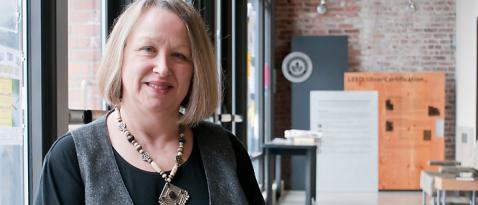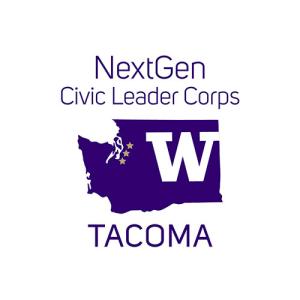A City in Pictures
Visiting Fulbright scholar Loraine Leeson, a London-based photographer and artist, says Tacoma is strikingly similar to East London.

Loraine Leeson, a London-based photographer and artist who is now serving as a Fulbright Scholar in Residence, says Tacoma is strikingly similar to East London, the community she’s called home for decades.
Nearly 5,000 miles and an ocean away from her native England, Loraine Leeson looks out of her office window and is reminded of home.
Leeson, a London-based photographer and artist who is now serving as a Fulbright Scholar in Residence in UW Tacoma’s Interdisciplinary Arts and Sciences program, says Tacoma is strikingly similar to East London, the community she’s called home for decades.
Both have deep roots in industry and immigration, both are haunted by a history of crime and poverty, and both are experiencing rebirth of nearly epic proportions.
It’s the sudden surge of development in East London that prompted Leeson to develop the Young Person’s Guide to East London, a website where local teenagers share photos and stories about their favorite places to shop, eat and hang out. And if all goes well, she’ll spend some of her brief time in Tacoma developing a similar project for this community.
It began a few years ago when London was selected as the host city for the 2012 Summer Olympics. Most of the Olympic events will take place in East London, bringing new development and visitors to an area that’s historically been the city’s poorest and most overcrowded neighborhood.
Leeson, a faculty member at the University of East London and the London East Research Institute, realized that there was little tourism information available for visitors to the area.
“I saw that there was no information for visitors, no guide to East London, especially for teenagers,” she said. “I decided we could use a participatory process to produce a guide just for young people.”
Working with teenagers from a number of schools, clubs and community groups, Leeson turned dozens of youngsters loose in East London with borrowed cameras.
After a brief training session in photography, their only instruction was to find and photograph the places they think visitors to the community should see — and come back with at least eight “really interesting” photos. The students downloaded and edited their own photos before filing them for use on the website.
“We ask them to show us their world, the real East London,” Leeson says. “What spots do you think are good? Where do you go shopping? Where do you buy your chips?”
While the guide is still growing, the students have already documented more than 150 sites, from cafes and flower shops to the Olympic park. Even though most of the youths have little photography experience, the quality of their work has been a pleasant surprise for Leeson.
“I’m often amazed. I didn’t expect them to take such good photos, and their pictures are just getting better and better. They come up with things you’d never expect.”
One student chose to document a park at night, explaining that youths often jump over the locked fences to smoke. Another focused on interesting signs in the area around the Olympic construction site.
Leeson will be at UW Tacoma through June, teaching art courses that focus on community-based art practice, cultural identity and public interaction. While she’s here, she hopes to work with local youth groups to begin work on a Young Person’s Guide to Tacoma. She needs to find funding, interested students and a champion to take on the project after she’s gone.
Like the project in London, Leeson says, a Tacoma guide would benefit both the community and the students who create it, giving them experience in photography and editing while offering them a chance to take ownership of a product that provides a needed service to their peers.
“They’re producing something real and useful,” she says. “They can make something other people will value, and that’s good for everybody.”



